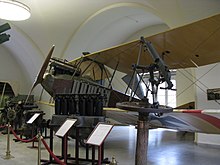Albatros B.I
| B.I | |
|---|---|

| |
| Paper model of Albatros B.I. | |
| Role | Reconnaissance aircraft |
| Manufacturer | Albatros Flugzeugwerke |
| Primary user | Luftstreitkräfte |
The Albatros B.I was a German military reconnaissance aircraft designed in 1913 and which saw service during World War I.[1]
Design and development
The B.I was a two-seat biplane of conventional configuration that seated the observer and the pilot in separate cockpits in tandem. The wings were originally of three-bay design, but were later changed to a two-bay, unstaggered configuration. A floatplane version was developed as the Albatros W.I.
Operational history
The B.Is were withdrawn from front line service in 1915 but some examples served as trainers for the remainder of the war.
Operators
- The Polish Air Force operated this type postwar.
Survivors

A surviving example of the B.I is preserved at the Heeresgeschichtliches Museum in Vienna.
Specifications (B.I)
Data from [2]
General characteristics
- Crew: 2
Performance
See also
Related development Albatros B.II - Albatros B.III - Albatros C.III - Lebed XI - Lebed XII Related lists
References
- ^ Taylor, Michael J. H. (1989). Jane's Encyclopedia of Aviation. London: Studio Editions. p. 51.
- ^ Gray, Peter; Owen Thetford (1970). German aircraft of the First World War (2nd ed.). London: Putnam. ISBN 0-370-00103-6.
